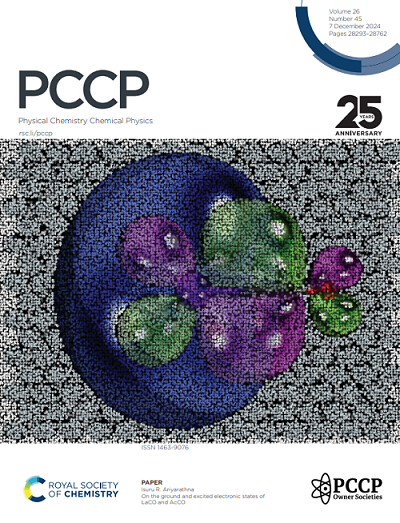Electrochemical Protonation/Deprotonation of TiNb2O7 in Protic Ionic Liquids
IF 2.9
3区 化学
Q3 CHEMISTRY, PHYSICAL
引用次数: 0
Abstract
In recent years, there has been growing interest in rechargeable batteries utilizing protons or hydronium ions as charge carriers, driven by the rapid ionic conduction enabled by the proton-specific Grötthuss mechanism. However, the use of acidic aqueous electrolytes introduces side reactions, such as irreversible hydrogen evolution and the dissolution of active materials into the electrolyte, which are influenced by the reaction potential of the active materials. These challenges complicate the identification and development of active materials. While some combinations of Brønsted acids and bases may potentially compromise the advantages of the Grötthuss mechanism, this study successfully demonstrated the electrochemical protonation of TiNb2O7 using protic ionic liquids as electrolytes. Acetic acid (AcOH) and 1,1,1-trifluoro-N-((trifluoromethyl)sulfonyl)methanesulfonamide (HTFSA) were employed as Brønsted acids, while 1-methylimidazole (Im) and 1,8-diazabicyclo[5.4.0]-7-undecene (DBU) were utilized as Brønsted bases. Irreversible hydrogen evolution was dominant in an aqueous buffer solution consisting of citric acid and trisodium citrate. The AcOH/DBU system showed negligible charge/discharge capacities within the cut-off potential range of −1.5 to +0.25 V. In contrast, AcOH/Im and HTFSA/Im systems exhibited reversible capacities of 61 and 55 mA h g⁻1, respectively, during the first cycle. However, their Coulomb efficiencies were significantly low below 20%. Meanwhile, HTFSA/DBU, despite a lower reversible capacity of 40 mA h g⁻1 (corresponding to H0.5TiNb2O7), achieved a Coulomb efficiency exceeding 90%. Notably, it maintained an average Coulomb efficiency of 96% over 50 cycles without any capacity degradation.近年来,人们对利用质子或氢离子作为电荷载体的充电电池越来越感兴趣,质子特异性格罗图斯(Grötthuss)机理可实现快速离子传导。然而,酸性水电解质的使用会带来副反应,如不可逆的氢演化和活性材料溶解到电解质中,这些副反应会受到活性材料反应电位的影响。这些挑战使活性材料的鉴定和开发变得更加复杂。虽然一些布氏酸和布氏碱的组合可能会损害格罗图斯机制的优势,但本研究成功证明了使用质子离子液体作为电解质对 TiNb2O7 进行电化学质子化。醋酸(AcOH)和 1,1,1-三氟-N-((三氟甲基)磺酰基)甲磺酰胺(HTFSA)被用作布氏酸,而 1-甲基咪唑(Im)和 1,8-二氮杂双环[5.4.0]-7-十一烯(DBU)被用作布氏碱。在由柠檬酸和柠檬酸三钠组成的缓冲水溶液中,不可逆氢演化占主导地位。相反,AcOH/Im 和 HTFSA/Im 系统在第一个循环中分别表现出 61 和 55 mA h g-1 的可逆容量。然而,它们的库仑效率明显低于 20%。与此同时,尽管 HTFSA/DBU 的可逆容量较低,仅为 40 mA h g-1(相当于 H0.5TiNb2O7),但其库仑效率却超过了 90%。值得注意的是,它在 50 个循环中保持了 96% 的平均库仑效率,而没有出现任何容量衰减。
本文章由计算机程序翻译,如有差异,请以英文原文为准。
求助全文
约1分钟内获得全文
求助全文
来源期刊

Physical Chemistry Chemical Physics
化学-物理:原子、分子和化学物理
CiteScore
5.50
自引率
9.10%
发文量
2675
审稿时长
2.0 months
期刊介绍:
Physical Chemistry Chemical Physics (PCCP) is an international journal co-owned by 19 physical chemistry and physics societies from around the world. This journal publishes original, cutting-edge research in physical chemistry, chemical physics and biophysical chemistry. To be suitable for publication in PCCP, articles must include significant innovation and/or insight into physical chemistry; this is the most important criterion that reviewers and Editors will judge against when evaluating submissions.
The journal has a broad scope and welcomes contributions spanning experiment, theory, computation and data science. Topical coverage includes spectroscopy, dynamics, kinetics, statistical mechanics, thermodynamics, electrochemistry, catalysis, surface science, quantum mechanics, quantum computing and machine learning. Interdisciplinary research areas such as polymers and soft matter, materials, nanoscience, energy, surfaces/interfaces, and biophysical chemistry are welcomed if they demonstrate significant innovation and/or insight into physical chemistry. Joined experimental/theoretical studies are particularly appreciated when complementary and based on up-to-date approaches.
 求助内容:
求助内容: 应助结果提醒方式:
应助结果提醒方式:


